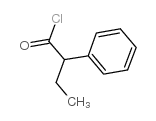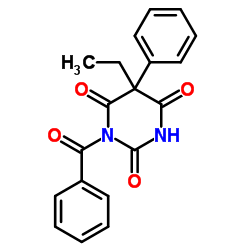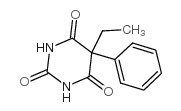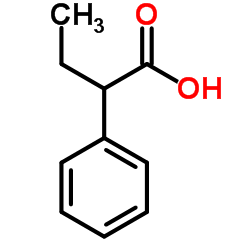90-49-3
| 中文名 | 苯丁酰脲 |
|---|---|
| 英文名 | 2-phenylbutyrylurea |
| 中文别名 |
乙苯乙酰脲
Beta刴ethoxynaph-talene 1-((乙基)苯乙酰)脲 |
| 英文别名 |
Lircapyl
Phenuride ETHYLPHENACEMIDE PBU EINECS 201-998-2 S 46 PHENETURIDE Benuride MFCD00069050 |
| 描述 | 苯巴比妥的脱羧产物苯乙脲(乙基苯乙酰胺,M 551)可用于预防精神运动性癫痫[1]。 |
|---|---|
| 相关类别 | |
| 参考文献 |
| 密度 | 1.15g/cm3 |
|---|---|
| 熔点 | 149.5 °C |
| 分子式 | C11H14N2O2 |
| 分子量 | 206.24100 |
| 精确质量 | 206.10600 |
| PSA | 72.19000 |
| LogP | 2.46630 |
| 折射率 | 1.547 |
| 储存条件 | 2-8°C, 密封, 干燥 |
| 分子结构 | 1、 摩尔折射率56.89 2、 摩尔体积(cm3/mol):179.2 3、 等张比容(90.2K):469.0 4、 表面张力(dyne/cm):46.8 5、 极化率(10-24cm3):22.55 |
| 计算化学 | 1.疏水参数计算参考值(XlogP):1.8 2.氢键供体数量:2 3.氢键受体数量:2 4.可旋转化学键数量:3 5.互变异构体数量:5 6.拓扑分子极性表面积72.2 7.重原子数量:15 8.表面电荷:0 9.复杂度:235 10.同位素原子数量:0 11.确定原子立构中心数量:0 12.不确定原子立构中心数量:1 13.确定化学键立构中心数量:0 14.不确定化学键立构中心数量:0 15.共价键单元数量:1 |
Synonym:alpha-Phenyl-alpha-ethylacetyl ure Section 2 - COMPOSITION, INFORMATION ON INGREDIENTS
Risk Phrases: 22 36/37/38 Section 3 - HAZARDS IDENTIFICATION EMERGENCY OVERVIEW
Harmful if swallowed. Irritating to eyes, respiratory system and skin. Potential Health Effects Eye: Causes eye irritation. Skin: Causes skin irritation. May be harmful if absorbed through the skin. Ingestion: Harmful if swallowed. May cause irritation of the digestive tract. Inhalation: Causes respiratory tract irritation. May be harmful if inhaled. Chronic: Not available. Section 4 - FIRST AID MEASURES Eyes: Flush eyes with plenty of water for at least 15 minutes, occasionally lifting the upper and lower eyelids. Immediately flush eyes with plenty of water for at least 15 minutes, occasionally lifting the upper and lower eyelids. Get medical aid. Skin: Get medical aid. Flush skin with plenty of water for at least 15 minutes while removing contaminated clothing and shoes. Ingestion: Get medical aid. Wash mouth out with water. Inhalation: Remove from exposure and move to fresh air immediately. If not breathing, give artificial respiration. If breathing is difficult, give oxygen. Get medical aid. Notes to Physician: Treat symptomatically and supportively. Section 5 - FIRE FIGHTING MEASURES General Information: As in any fire, wear a self-contained breathing apparatus in pressure-demand, MSHA/NIOSH (approved or equivalent), and full protective gear. Extinguishing Media: Use water spray, dry chemical, carbon dioxide, or chemical foam. Section 6 - ACCIDENTAL RELEASE MEASURES General Information: Use proper personal protective equipment as indicated in Section 8. Spills/Leaks: Vacuum or sweep up material and place into a suitable disposal container. Section 7 - HANDLING and STORAGE Handling: Avoid breathing dust, vapor, mist, or gas. Avoid contact with skin and eyes. Storage: Store in a cool, dry place. Store in a tightly closed container. Section 8 - EXPOSURE CONTROLS, PERSONAL PROTECTION Engineering Controls: Facilities storing or utilizing this material should be equipped with an eyewash facility and a safety shower. Use adequate ventilation to keep airborne concentrations low. Exposure Limits CAS# 90-49-3: Personal Protective Equipment Eyes: Not available. Skin: Wear appropriate protective gloves to prevent skin exposure. Clothing: Wear appropriate protective clothing to prevent skin exposure. Respirators: Follow the OSHA respirator regulations found in 29 CFR 1910.134 or European Standard EN 149. Use a NIOSH/MSHA or European Standard EN 149 approved respirator if exposure limits are exceeded or if irritation or other symptoms are experienced. Section 9 - PHYSICAL AND CHEMICAL PROPERTIES Physical State: Crystalline powder Color: white Odor: Not available. pH: Not available. Vapor Pressure: Not available. Viscosity: Not available. Boiling Point: Not available. Freezing/Melting Point: 149 - 152 deg C Autoignition Temperature: Not available. Flash Point: Not available. Explosion Limits, lower: Not available. Explosion Limits, upper: Not available. Decomposition Temperature: Solubility in water: Specific Gravity/Density: Molecular Formula: C11H14N2O2 Molecular Weight: 206.24 Section 10 - STABILITY AND REACTIVITY Chemical Stability: Stable under normal temperatures and pressures. Conditions to Avoid: Incompatible materials. Incompatibilities with Other Materials: Strong oxidizing agents. Hazardous Decomposition Products: Nitrogen oxides, carbon monoxide, carbon dioxide. Hazardous Polymerization: Has not been reported Section 11 - TOXICOLOGICAL INFORMATION RTECS#: CAS# 90-49-3: YU1225000 LD50/LC50: CAS# 90-49-3: Oral, mouse: LD50 = 910 mg/kg; Oral, rat: LD50 = >2063 mg/kg. Carcinogenicity: Pheneturide - Not listed by ACGIH, IARC, or NTP. Other: See actual entry in RTECS for complete information. Section 12 - ECOLOGICAL INFORMATION Section 13 - DISPOSAL CONSIDERATIONS Dispose of in a manner consistent with federal, state, and local regulations. Section 14 - TRANSPORT INFORMATION IATA Not regulated as a hazardous material. IMO Not regulated as a hazardous material. RID/ADR Not regulated as a hazardous material. Section 15 - REGULATORY INFORMATION European/International Regulations European Labeling in Accordance with EC Directives Hazard Symbols: XN Risk Phrases: R 22 Harmful if swallowed. R 36/37/38 Irritating to eyes, respiratory system and skin. Safety Phrases: S 26 In case of contact with eyes, rinse immediately with plenty of water and seek medical advice. S 37/39 Wear suitable gloves and eye/face protection. WGK (Water Danger/Protection) CAS# 90-49-3: No information available. Canada None of the chemicals in this product are listed on the DSL/NDSL list. CAS# 90-49-3 is not listed on Canada's Ingredient Disclosure List. US FEDERAL TSCA CAS# 90-49-3 is not listed on the TSCA inventory. It is for research and development use only. SECTION 16 - ADDITIONAL INFORMATION N/A |
CHEMICAL IDENTIFICATION
HEALTH HAZARD DATAACUTE TOXICITY DATA
|
| 危害码 (欧洲) | Xi |
|---|---|
| 危险品运输编码 | UN 3249 |
| 包装等级 | III |
| 危险类别 | 6.1(b) |
|
~% 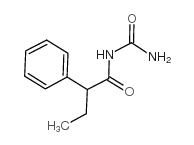
90-49-3 |
| 文献:Journal of the American Chemical Society, , vol. 58, p. 1352 Chem. Zentralbl., , vol. 106, # I p. 1271 Journal of the Chemical Society, , p. 220,222 |
|
~30% 
90-49-3 |
| 文献:Polish Journal of Chemistry, , vol. 57, # 7-9 p. 799 - 807 |
|
~% 
90-49-3 |
| 文献:Journal of the American Chemical Society, , vol. 58, p. 1352 Chem. Zentralbl., , vol. 106, # I p. 1271 Journal of the Chemical Society, , p. 220,222 |
|
~% 
90-49-3 |
| 文献:Acta Academiae Aboensis, Series B: Mathematica et Physica, , vol. 10, # 10 p. 8,15,19,22 Chem. Zentralbl., , vol. 108, # II p. 2004 |
|
~% 
90-49-3 |
| 文献:Chemische Berichte, , vol. 119, # 2 p. 669 - 682 |
|
~% 
90-49-3 |
| 文献:DE249241 ; Fortschr. Teerfarbenfabr. Verw. Industriezweige, vol. 10, p. 1165 |
|
~% 
90-49-3 |
| 文献:Journal of the American Pharmaceutical Association (1912-1977), , vol. 38, p. 409 |


